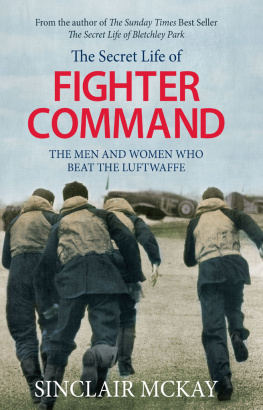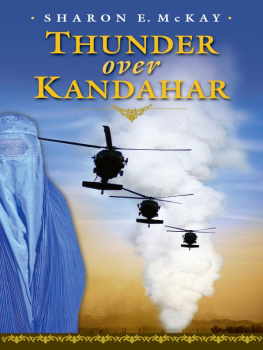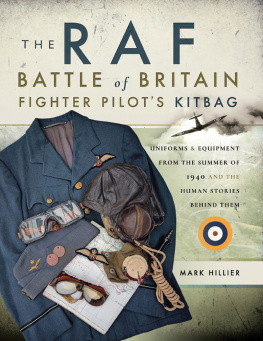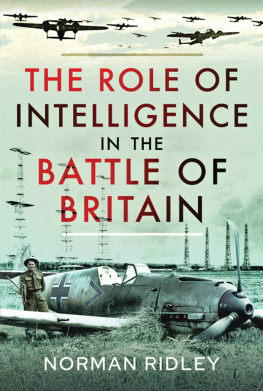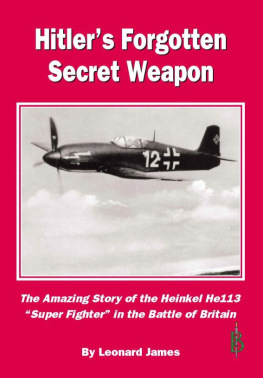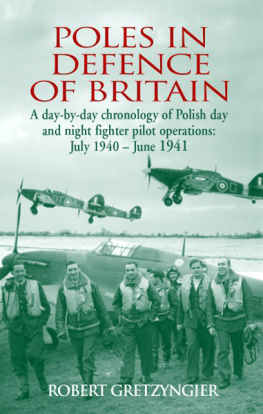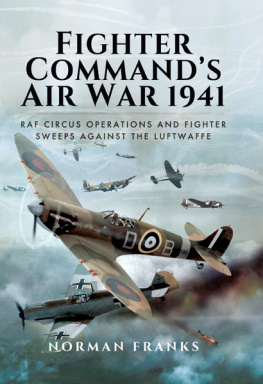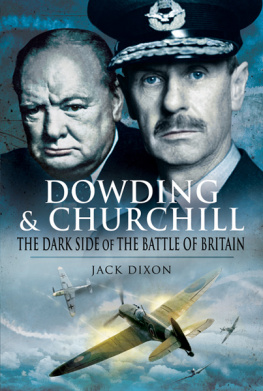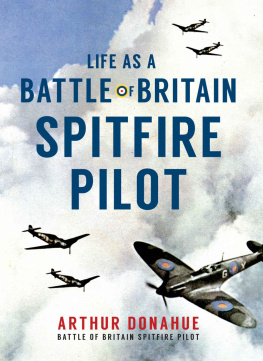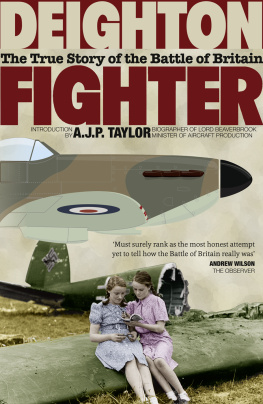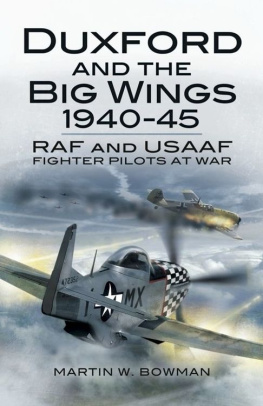The Secret Life of
Fighter Command
Contents
Be calm, Hitler had told the Berlin crowds. He is coming. He is coming.
Late on the afternoon of 7 September 1940, the warmth of summer lingered in the hazy air over England; and the graceful whorls and curls of white in the blue sky above the South Downs might either have been innocent clouds or the last traces of a distant aerial fight. On the chalk ridges and green slopes below, and in the bustling lanes of south coast towns from Portsmouth to Dover, civilians were making the most of the temporary lull and were tensed for the next attack. For the past few weeks, huge numbers of people had watched with guileless fascination as, high above, planes had swooped and swerved, describing wide circles as they chased one another. From that distance, even an exploding fuel tank hit by gunfire a split second of glittering gold and orange, followed by the plane simply falling out of the sky was hypnotic rather than frightening.
It was almost a different war. Across the grey waters of the Channel, on the continent and deep in the darkness of Europe, the conflict had been lumbering, ugly, brutally functional. Vast tanks that jerked and manoeuvred in unnatural lines, vast guns roaring beyond human reason; and everywhere the mortal wreckage of red, glisteningviscera. But here, high above in the blue, no one could look away from the Spitfires and the Messerschmitts. Every fleet movement, from climbs to dives, had an innate elegance, a geometrical beauty even as the pilots were flying for their lives.
British pilots had been fighting continuously in these skies for days and weeks; physically and mentally, they had been taken to the edge. The fear that kept them focused during sorties left them exhausted in the aftermath, with the result that many of these men were working by pure instinct. That summer, their squadrons had faced an enemy that seemed not only relentless but also apparently limitless in number. No matter how many German planes they shot out of the sky, the next day brought fresh formations. Perhaps a few RAF pilots sensed just how heavily the odds were stacked against them. Yet, paradoxically, even if they had not been required to risk their lives on an hourly basis, these men would still have been desperate to fly. (By contrast, think of the soldiers who drove tanks; imagine if they yearned to drive a tank for the love of it.) The nature of this war in the air was technologically new, yet as old as Arthurian legend. The RAF pilots were not just warriors. Flying, for them, was a metaphysical pleasure.
But that Saturday, this celestial ballet, as one mesmerised onlooker had described it, took on a different character. There were specially trained plane-spotters at Dover, at Folkestone, at Lympne, and dotted around the north Kent coast. The job of these volunteers many of whom, proud men, had served in the First World War was to report, instantly, the type and the numbers of enemy bombers flying in overhead. On that Saturday, the Observer Corps heard the storm before they saw it; at first a pervasive note, a deep unearthly hum, like some distant male choir. In their small dugouts often not much more than rudimentary woodenhuts the bells of their telephones had started ringing a little while beforehand. He was coming; Hitler, characterising the German air force and its massed bombers as the physical projection of his will, had announced his intentions in a speech to hundreds in Berlin.
A few days before this, the British had launched a bomber assault on Germany; on the night of 25 August 1940, the pilots had flown their planes to the very limit that fuel would allow. Their targets were Berlins airport and other strategic sites. As with all bombing raids, there were imprecise hits, collateral damage.
Compared with what was to follow years later, the destruction was not great. But the response to that August raid was incandescent; the Fhrers aim was changed. Forget the RAF airfields and the convoys and the neat tactical targets. Instead: pour hellfire down upon the civilians of London.
The intelligence gathered from Y Service operatives (the Y short for wireless), who were listening in to Luftwaffe messages had confirmed that he was coming. The operatives of the coastal radar stations had looked into the cathode ray tubes and seen the assembling force represented as an electronic echo. The number of blips was unprecedented. That afternoon, stations in Dover and Rye picked up the same readings.
The low unearthly hum deepened, acquiring a new timbre or vibration. The Observer Corps volunteers would have been among the first to see them, at 4.15 p.m., through their binoculars. Rows of black dots that grew larger, resolved, drawing closer to the White Cliffs, perfectly unstoppable. These men were not there merely to report on the appalling spectacle. From their small posts on hills high above the sea, on the edges of fields, with instruments like astrolabes set out on tables before them, they started telephoning their observations to the local Observer Corps headquarters inMaidstone, Kent. They reported the numbers of enemy bombers that were flying towards and over them, along with the height at which they were flying (calculated by means of that specially designed instrument). The Observer Corps like the coastal radar operatives were among the first to feel the horrified thrill of atavistic awe; rather than the usual enemy formations, these disciplined rows of aeroplanes, black in the sunlight, seemed to be coming line after line. First, about 100 were seen; then 200. Then yet more were reported, coming from different angles, different aerodromes, but heading for one target. An estimated 1,100 German aeroplanes flew in over the south coast that Saturday afternoon. On previous occasions, large formations had fragmented, broken off in varying directions, feinted, lured British pilots into redundant battles while others snaked towards their bombing targets. At tea-time that warm day, these hundreds of German planes were making their way high across the orchards of Kent towards the brown industrial air of the nations capital. Waiting until the last possible moment, in order to conserve fuel, RAF pilots, based at aerodromes ringing the capital and dotted throughout the swards of Kent and Sussex, awaited their orders to intercept.
Before any orders went out, the aerodromes needed very quickly an idea of where pilots were to fly to, and how many would be needed. They needed to be able to comprehend the scale and purpose of this gargantuan raid. Such intelligence was secretly gathered beneath a property on the northwestern edge of London, in the heart of what poet John Betjeman called Metroland. In the gardens of Bentley Priory a grand eighteenth-century house that had once hosted poets and princes was a large chamber buried some thirty feet beneath the earth. It was to this room that the calculations of the Observer Corps volunteers, together with the readings from the new radar stations, werephoned through, to be instantly received and analysed by volunteers from the Womens Auxiliary Air Force (WAAF) in what was called the Filter Room; their calculations translated into vectors and co-ordinates were then passed to the Operations Room.
There, on a large map, coloured counters were deployed to represent the forces that were flying in. From here, the intelligence radiated outwards again on telephone lines, to aerodromes up and down the land. The secret bunker and the grand house formed the headquarters of Fighter Command. Bentley Priory was, throughout that summer, the crucible in which the course of the war was shaped.
This cats cradle network of intelligence the bluff old Observer Corps men, the dedicated and intelligent women, and the eager young civilian scientists looking after the brand-new radar technology had been painstakingly devised by a commander who was misunderstood and treated with cold contempt by his superiors. Air Chief Marshal Sir Hugh Dowding was an austere figure who had throughout his life in the RAF seen the science of flying turn from a rare miracle of daring and aeronautic skill to a new, modern branch of warfare. His Fighter Command system was designed with tremendous skill and care, the armourers science and guile supporting the knights of the air.
Next page
